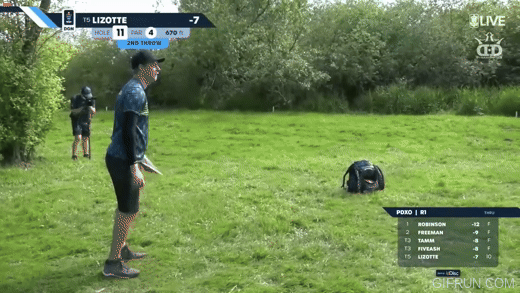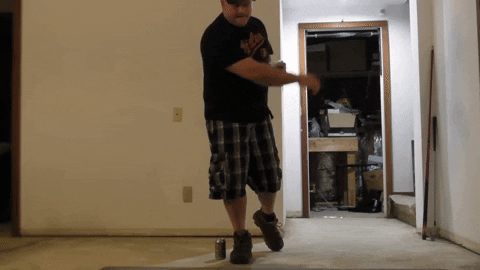I'd love to get you guys take on the safety and power output of this "move".
The biggest thing I notice when trying or seeing others try the whole "rear knee behind the front knee" method, is that it feels like you are cutting off a safety mechanism from the body. For me, the rear leg moving to a counterweight position happens naturally as more hyzer tilt is added, but never quite to the extent taught here. When I HAVE tried to force that movement, it immediately feels dangerous to my body. By forcing the rear leg way behind, the momentum seems to shift in a way where I am "locked" behind my brace. The front toe lift and pivot seems much less natural and later. Admittedly, that does sound nice for maximum efficiency, but in practice, it ends up feeling like there are 3 outcomes.
Least likely.
Form is good enough and knee is strong enough that efficiency goes up and more of the momentum goes into the throw. DWJ style front leg taking a blasting and even hyperextension.
Most likely.
The body just limits the force I'm producing with the front leg because it feels like it's going to shear my knee in half. It wont let me go full power because it knows I can't dissipate the energy from that position. I don't see a gain because my body won't let it happen.
Worst case.
My form ISNT good enough and my body isn't strong enough. I end up forcing the body to go full bore while locked behind the brace and I cause an injury.
My worry is the last case. I don't know how safe the move is for everyone, and have a hunch it might be safer for people with certain internal hip bias and mobility. I have seen quite a few people on video and locally start using this move and it immediately looks like their front foot is having alot of trouble naturally opening. It is made worse when you close the front foot even more to the target. It also seems way worse if the student isn't quite at the point where they can get to a straight leg at some point. Knee ends up bent with a ton of shearing force going sideways through the knee and the muscles protecting the knee aren't engaged.
I'm not totally sure how right this is, it's just what I personally have noticed trying it and seeing others try it. Some of the videos I have seen make me cringe at the front foot pivoting crazy late as the front hip has already bounced off maximum ROM of internal rotation. For me at least, my body screams at me when I try this technique and I've had to wear a knee sleeve because of pain when I went down this road early in my learning to throw journey.
As for the hip drop portion, I have never felt any real power "from gravity" by just dropping my rear hip down. Seems like it would be a crazy low amount in comparison to everything else we are bringing in and adding.
Hey
@Clint Easterly, glad you're hear and would be interested in your thoughts here too:
Since I mostly think (and learn) in terms of posture and balance (sorry the first one is a bit long, but I wanted to be thorough):
1.
"The biggest thing I notice when trying or seeing others try the whole "rear knee behind the front knee" method, is that it feels like you are cutting off a safety mechanism from the body. For me, the rear leg moving to a counterweight position happens naturally as more hyzer tilt is added, but never quite to the extent taught here. When I HAVE tried to force that movement, it immediately feels dangerous to my body. By forcing the rear leg way behind, the momentum seems to shift in a way where I am "locked" behind my brace. The front toe lift and pivot seems much less natural and later. Admittedly, that does sound nice for maximum efficiency, but in practice, it ends up feeling like there are 3 outcomes."
IMHO most people see an "X-step" and unfortunately think and look only at the X part, but not all
the rest of what's happening around the move. That's why increasingly I just think of it as the "transition move" - it's the transition from whatever number of steps you took before, to the critical phase of building up torque in the backswing while you let momentum keep flowing forward into the plant.
Weissman is getting the posture and balance points confused as described earlier in the thread, and this is a common error when people do not have the preferred balance and posture in transition.
Even in people throwing very far and not quite tour level, they always tend to have some bits that could improve the transition move. Because everything that happens after this part of the move depends on its quality, time spent there is rarely wasted (FWIW, my 2 cents, YMMV, etc.).
When Sidewinder uses hammer and pump drills, what he's really doing is trying to teach the body to move in reciprocating, balanced ways. For example in his "
hammer x-step," he teaches basically that the full pump is basically helping the whole body move forward, and also help the rear leg swing in crossing behind. It's never really about the knee or knees - that's an
effect, not the goal. Notice also that his entire body is tilted with the move, and that is actually part of where the real "X" of the "X-step" occurs: it's actually two whips crossing the body from one foot to the opposite hand. Same idea as his Double Dragon drill. Other people teach it differently of course. I wouldn't generalize from myself, but misunderstanding what
causes the cross behind is part of what damaged both of my knees. Learning to get more natural motion patterns to work together has helped immensely.
That more fundamental idea is also why I think you can see
"shuffle hops" and "x-steps/hops" on tour, and both are functional. They're doing the "same" thing as one another - a full X probably creates more internal torque and subtle or large centrifugal effects, and a side shuffle hop probably produces more lateral momentum. I'm not sure how much is strictly form alone - probably also some body differences player to player for however they comfortably transition athletically, perhaps. I've had my thoughts about whether one is "safer" than the other, but I guess the presence of both suggests they can be used at a high level repeatably.
Paul Mcbeth still has the most versatile weight shifts I think we've ever seen. He changes between shuffle hops and more X, more or less height and width, more or less whole body tilted balance, more or less pump size and momentum, different leverage points, etc. from shot to shot and over time. I'm still working on my own rear side transition move and I find messing around with the
whole body tilt/hip depth and pump size and
hip hinge all useful when learning to move since they're all connected in transition. In general I think more athletic/flexible players with stronger and mobile legs can pull off the deeper hinges like Paul - I am using a bit more right now when slowing down to learn to move through the X/hop transition and for placement shots, and for power shots tend to get less hinged/taller again like Feldberg due to my body type/limits. I change the size of the pump but always use it to an extent to emphasize what my body learned about the natural flow of motion through the whole body like Hammer X step, and visualizing McBeth always helps me the most with the pump versatility.
2.
Least, most, worst...
Yes, I think that is about where I'd put it.
3.
Injury potential:
I was/am slightly still a risk of shear force student. Big body, poor coordination, and weak legs for my size unfortunately taught me first hand a lot of what can go wrong, and fortunately Sidewinder has thought deeply about all of this stuff for more than a decade and moved me into a much better space of movement. That's why I now also conceptualize & try to share concepts that turn the move into the most natural, athletic, low effort motion a given body can do while also achieving power (which adapts over years, with experience and fitness, etc. of course).
4.
As for the hip drop portion, I have never felt any real power "from gravity" by just dropping my rear hip down. Seems like it would be a crazy low amount in comparison to everything else we are bringing in and adding.
I've tried and seen others do both and in general this seems true. Rather than say all the details I find interesting, I just want to say getting off the rear leg much more like Hershyzer/pitcher's stride is always much more powerful while also emphasizing the balance and posture going into the move. Since I have a lot of body mass and enough issues with my rear leg already the difference is very noticeable to me.
The gravity effect "should" work much more like the Hershyzer drill, and that drill should also be carrying forward any of the momentum from the X-step or shuffle hop etc. that preceded it. There are probably dozens or hundres of unique ways that people block their ideal action. I'm still learning about them and seeing new little "subspecies," even in (maybe especially in) very athletic and far throwers now, and including in those who are teaching, too. Many of them could (and do learn to) gain distance by improving the transition move to each the "better" way to use gravity (quotations only out of a healthy sense of open mindedness, but I think the pro-level move is typically fundamentally the same across players more than it is different.
IMHO the "back leg/front leg" throwing "debate" (mostly just echo chambers) is silly and a complete non-issue when you understand the rest of the ideal balance and posture context of the move).











